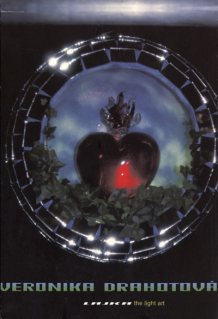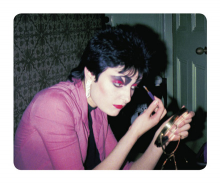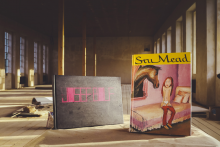| Zeitschrift Umělec 2003/3 >> JUSTICE IN THE ARMS OF THE YELLOW PIERROT | Übersicht aller Ausgaben | ||||||||||||
|
|||||||||||||
JUSTICE IN THE ARMS OF THE YELLOW PIERROTZeitschrift Umělec 2003/301.03.2003 Jiří Ptáček | neuigkeiten | en cs |
|||||||||||||
|
"The 8th Biennial in Istanbul,
Sept. 18 – Nov. 16, 2003 A reasonable multicultural show — that’s how the biennial in Istanbul could be characterized. Last year the Turkish organizers requested American curator Dan Cameron to put on the biggest exhibition in the country. This employee of New York’s New Museum of Contemporary Art demonstrated to the skeptics of international monster actions that one can still take into consideration the context of the location in which the show is held, and that one can pick a main theme capable of surviving potential digressions and partial diversions. Istanbul has ten million citizens and is a truly modern city. Part European, part Asian, part mythical origins along with the historical cataclysms of the East and West. And part contemporary Turkish republic. In short, a place where questions on identity and mutuality swarm and Dan Cameron interpreted Istanbul in much the same way. He picked 85 artists from around the world. Unfortunately no one from our forests and hills made it, but a visit to the biennial showed why. The key here wasn’t nationality and no locality received specific attention. He emphasized the fact that artists are moving local metaphors more and more obviously towards displays of social injustice. This attitude is true simultaneously around the planet, and in this sense is a global feature of resistance and criticism. The content of Poetic Justice, the title of the show, was discovered directly in reactions to an aggressive social reality. “The most compelling motivation for linking poetry and justice comes in response to the devaluation of the spiritual in all its potential manifestations, which has become such a striking hallmark of contemporary Western society that the art of our time has responded by insisting that the realms of materiality and consciousness are not only equally vital, but, in the final analysis, inseparable,” wrote Dan Cameron in the report to the Biennial. And this was confirmed by a very concentrated feat, at least on the ground level of the hangar Antrepo No. 4, designed in the 1950s by American army architects. The absolute predominance of videos and video installations represented not only the popularization of digital media, but also the tendency to tell stories, either in the form of documentary reference or imaginative creation. The ground floor of Antrepo itself might stand for the very intense feeling of peril that pervades the world. The artist presents the causes of economic disparity among the continents, political and cultural repression in the countries of the third world and the permanent threat of war while being conscious of the innumerable human rights violations, as they are represented in global communication and the expanding democratic ideas of the West. On the other hand, the artist records the negative results of exercising these ideas. “In contemporary art, the hegemony of the material universe is even reflected in the drift towards art as an exclusively social and political vehicle, wherein the role of the artist is to call attention to a set of circumstances in the material world that had previously been overlooked or misunderstood,” said Cameron in the press release. And in a report in the catalogue he remarked: “The potential of global citizenship, the importance of which underlies my choice of many artists and works for this exhibition, entails a recognition that the ideals of justice, like all other cultural values, exist in some instances as absolutes and in others as largely relativistic principles.” Taking part in justice can only happen when its inner entropy has been revealed. The second floor of Antrepo, the Yerebatan cistern or the former cannon foundry from the 15th century, was transformed into the exhibition space Tophane-i Amire Cultural Centre, and it completed and developed this perfectly well-handled and crucial part of the Biennial. The installations and projections over the water of the Yerebatan cistern paid attention to the mirroring and attractiveness of the place, and the tourists crowded in; the second floor of Antrepo then showed that the claim to poetic justice could be traced to the description of intimate tragedies and sexual taboos, and that it naturally penetrates more media than just digital. Only a few works in the museum and former temple Hagia Sofia seemed to be a wasted opportunity. If Antrepo had tried to answer unambiguously questions about justice in the present day, it would have surrendered to careful and cowardly formulations. The idea that the world rolls over to never -ending strife, that the tendency to unify ethics faces deep differences of cultural roots and still it unavoidably wins our hearts, was visible on every corner in Istanbul. At the opening Dan Cameron wore a banana-colored suit, and contentedly rubbed his hands hidden within his white gloves. "
01.03.2003
Empfohlene Artikel
|
|||||||||||||
|
04.02.2020 10:17
Letošní 50. ročník Art Basel přilákal celkem 93 000 návštěvníků a sběratelů z 80 zemí světa. 290 prémiových galerií představilo umělecká díla od počátku 20. století až po současnost. Hlavní sektor přehlídky, tradičně v prvním patře výstavního prostoru, představil 232 předních galerií z celého světa nabízející umění nejvyšší kvality. Veletrh ukázal vzestupný trend prodeje prostřednictvím galerií jak soukromým sbírkám, tak i institucím. Kromě hlavního veletrhu stály za návštěvu i ty přidružené: Volta, Liste a Photo Basel, k tomu doprovodné programy a výstavy v místních institucích, které kvalitou daleko přesahují hranice města tj. Kunsthalle Basel, Kunstmuseum, Tinguely muzeum nebo Fondation Beyeler.
|

































 We Are Rising National Gallery For You! Go to Kyjov by Krásná Lípa no.37.
We Are Rising National Gallery For You! Go to Kyjov by Krásná Lípa no.37.
Kommentar
Der Artikel ist bisher nicht kommentiert wordenNeuen Kommentar einfügen